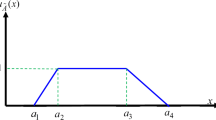Abstract
Evaluation of the shortest path in a wireless network is to ensure the fast and guaranteed delivery of the data over the established wireless network. Most of the wireless protocols are using a shortest path evaluation technique which is based on the random weights assigned to the network nodes. This alone may not be sufficient to get the accurate shortest path for routing process. Most of the shortest path evaluation algorithms perform the blind search to find the shortest routes for routing, this eventually increase the complexity of the whole process itself. This article puts some light on facts of using real time estimated routing delay from source node to other nodes by broadcasting a “knock” message. And this delay is being used to evaluate the shortest path for routing using fuzzy logic. This process is enhanced with its improved inference engine model and furnished fuzzy crisp patterns to deploy the shortest routing path in real time wireless nodes.








Similar content being viewed by others
References
Goldberg, A. V., & Radzik, T. (1993). A heuristic improvement of the Bellman–Ford algorithm. Applied Mathematics Letters, 6(3), 3–6.
Magzhan, K., & Jani, H. M. (2013). A review and evaluations of shortest path algorithms. International Journal of Scientific & Technology Research, 2(6), 99–104.
Bhuiyan, M. D. Z. A., & Wang, G. (2014). Reliable shortest paths in wireless sensor networks: Refocusing on link failure scenarios from applications. In IEEE. https://doi.org/10.1109/prdc.2014.
Khan, P., Konar, G., & Chakraborty, N. (2014). Modification of Floyd–Warshall’s algorithm for shortest path routing in wireless sensor networks. In Annual India, IEEE conference. ISBN 978-1-4799-5364-6/14.
Magzhan, K., & Jani, H. M. (2013). A review and evaluations of shortest path algorithms. International Journal of Scientific and Technology Research. ISSN 2277-8616.
Cota-Ruiz, J., & Rivas-Perea, P. (2016). A recursive shortest path routing algorithm with application for wireless sensor network localization. IEEE Sensors Journal, 16, 4631–4637.
Gubichev, A., Bedathur, S., & Seufert, S., & Weikum, G. (2010). Fast and accurate estimation of shortest paths in large graphs. ACM 978-1-4503-0099-5/10/10.
Johnson, D. B. (1977). Efficient algorithms for shortest path in sparse networks. Journal of the Association for Computer Machinery, 24(1), 1–13.
Jiang, J.-R., Huang, H.-W., Liao, J.-H., & Chen, S.-Y. (2014). Extending Dijikstra’s shortest path algorithm for software defined networking. APNOMS.
Gla, M., Musznicki, M., Nowak, P., & Zwierzykowski, P. (2013). Efficiency evaluation of shortest path algorithms. ISBN 978-1-61208-279-0, IARIA.
Ying, L., Shakkottai, S., Reddy, A., & Liu, S. (2010). On combining shortest-path and back-pressure routing over multihop wireless networks. IEEE/ACM TRANSACTIONS ON NETWORKING, 1063-6692.
Mali, G. U., & Gautam, D. K. (2017). A model application of two phase commit protocol in wireless DTN. International Journal of Computer Applications, 162(5), 23–28.
Thippeswamy, K., Hanumanthappa, J., & Manjaiah, D. H. (2010). A study on contrast and comparison between Bellman–Ford algorithm and Dijkstra’s Algorithms. Research gate, publication/209423960
Abbasi-Daresari, S., & Abouei, J. (2015). Toward cluster-based weighted compressive data aggregation in wireless sensor networks. Ad Hoc Networks, Elsevier B. V.
Author information
Authors and Affiliations
Corresponding author
Additional information
Publisher’s Note
Springer Nature remains neutral with regard to jurisdictional claims in published maps and institutional affiliations.
Rights and permissions
About this article
Cite this article
Mali, G.U., Gautam, D.K. Shortest Path Evaluation in Wireless Network Using Fuzzy Logic. Wireless Pers Commun 100, 1393–1404 (2018). https://doi.org/10.1007/s11277-018-5645-1
Published:
Issue Date:
DOI: https://doi.org/10.1007/s11277-018-5645-1




